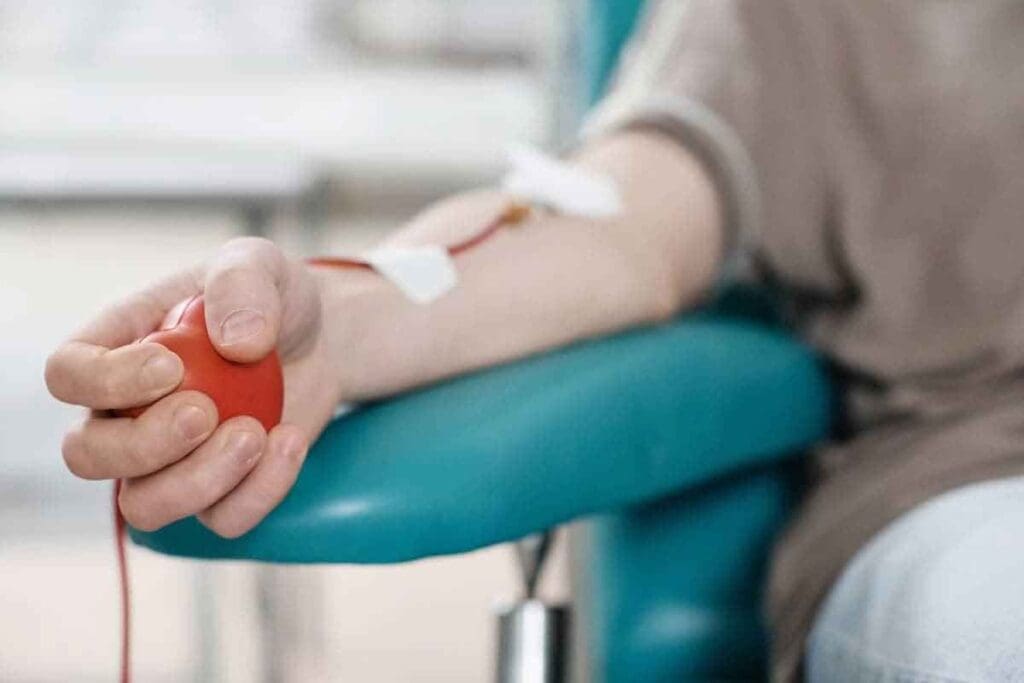Last Updated on November 14, 2025 by Ugurkan Demir

Hemoglobin is a key protein found in red blood cells. It’s vital for carrying oxygen to the body’s tissues. This protein is made of iron and helps move oxygen from the lungs to the body’s tissues.
Almost all vertebrates have hemoglobin, except for the fish family Channichthyidae. Knowing what hemoglobin is helps us understand its role in biology.
Hemoglobin is key to life as an oxygen-carrying protein in our blood. It’s made of four chains, each with an iron-rich heme group. This setup lets hemoglobin grab and let go of oxygen, making it vital for our survival.
Hemoglobin is a protein in red blood cells that carries oxygen to our body’s tissues. It can hold 1.34 mL of O2 per gram, boosting blood’s oxygen capacity. The iron in its heme group is what binds oxygen, enabling it to transport oxygen.
To grasp what hemoglobin does, we must look at its makeup and how it works. Its four chains team up to bind and release oxygen. This is key for delivering oxygen to our body’s cells, supporting life.
Hemoglobin is vital because it carries oxygen from our lungs to our body’s tissues. Without enough, our cells wouldn’t get the oxygen they need. This could cause harm and even be deadly.
Hemoglobin plays many roles:
In short, knowing about hemoglobin shows its critical role in life. Its structure lets it bind and release oxygen well. This makes it a key part of our circulatory system.

Understanding hemoglobin’s molecular structure is key to knowing its role in oxygen transport. It’s a complex protein in red blood cells that carries oxygen from the lungs to the body’s tissues. Its structure is vital for this function.
Hemoglobin is made of four polypeptide chains: two alpha and two beta chains in adults. These chains are essential for its structure and function. Each chain has a heme group with iron, which helps hemoglobin bind and transport oxygen well.
The way these chains and heme groups are arranged lets hemoglobin change shape when it binds oxygen. This change helps release oxygen to tissues.
The heme group is vital for hemoglobin’s oxygen-binding ability. The iron in it plays a key role. When oxygen binds to the iron, it changes hemoglobin’s shape, improving its oxygen-carrying ability.
The iron in the heme group is essential for hemoglobin’s function. Without it, hemoglobin can’t bind or transport oxygen, causing severe problems.
There are different types of hemoglobin throughout life. For example, fetal hemoglobin in infants has a higher oxygen affinity than adult hemoglobin. This allows it to effectively get oxygen from the mother’s bloodstream.
As we grow, the type of hemoglobin in our red blood cells changes. Knowing these changes helps us understand hemoglobin’s complex role in human physiology. It also helps address disorders related to hemoglobin abnormalities.
Recent research has highlighted hemoglobin’s ability to transport carbon dioxide and nitric oxide. It plays a role in pH regulation and redox balance. This shows hemoglobin’s importance beyond just oxygen transport.
Hemoglobin is key to keeping our bodies balanced. It does this through many important functions. We’ll see how its structure helps it do these jobs well.
Oxygen Transport: Hemoglobin is best known for carrying oxygen from our lungs to our tissues. It does this by binding oxygen to its heme group, creating oxyhemoglobin. This high affinity lets it grab oxygen in the lungs and release it to our tissues.
Oxygen transport is a complex process. It involves oxygen binding to hemoglobin’s four subunits. When oxygen binds to one subunit, it makes the others more eager to bind oxygen too. This helps hemoglobin pick up oxygen in the lungs. When oxygen is released to the tissues, the binding affinity drops, making it easier to release.
Hemoglobin also carries carbon dioxide from our tissues back to the lungs. About 20-25% of our respiratory carbon dioxide is carried by hemoglobin. This helps keep our body’s acid-base balance.
Hemoglobin also helps regulate nitric oxide (NO) levels in our bodies. Nitric oxide is involved in many physiological processes, like vasodilation. Hemoglobin can bind to NO, affecting its availability. This impacts our vascular tone and blood pressure.
“The ability of hemoglobin to transport and regulate various gases highlights its importance in maintaining proper physiological function.”
In summary, hemoglobin’s main roles in our bodies are not just about oxygen transport. It also carries carbon dioxide and regulates nitric oxide. Understanding these roles shows how vital hemoglobin is to our health.
It’s important to know about hemoglobin disorders to diagnose and treat health issues. These disorders can greatly affect a person’s health. They cause problems because of changes in how hemoglobin is made or works.
Sickle cell anemia is a genetic disorder. It happens because of a change in the hemoglobin gene. This change leads to abnormal hemoglobin, called HbS.
Red blood cells with this abnormal hemoglobin don’t carry oxygen well. People with sickle cell anemia may feel pain, have anemia, and get sick more easily.
Thalassemias are genetic disorders that affect hemoglobin production. They cause anemia and other problems. The severity of these disorders depends on how many genes are affected.
Treatment can include regular blood transfusions or even bone marrow transplantation for severe cases.
Conditions like hemoglobin C and E also affect hemoglobin. They result from changes in the hemoglobin gene. These changes can have big health effects and need proper treatment.
It’s key to understand these disorders to give the right care.
Research on hemoglobin is uncovering its role in health and disease. It matches Liv Hospital’s goal for top-notch medical care. This research is key to improving health outcomes.
Knowing what haemoglobin is and how it works is vital. It helps us understand its role in carrying oxygen and other functions. New studies have greatly enhanced our understanding of hemoglobin and related diseases.
Understanding hemoglobin is critical for diagnosing and treating related conditions. Ongoing research shows the need for excellence and thorough study in healthcare. This helps us tackle health challenges better.
As we learn more about hemoglobin, we can offer better healthcare. This includes top-notch care and support for patients worldwide.
Hemoglobin is a key protein in red blood cells. It’s vital for delivering oxygen to the body’s tissues. This protein helps transport oxygen from the lungs to the body’s tissues, supporting life and energy production.
Hemoglobin is a protein that carries oxygen in the body. It’s essential for life. Its iron helps it bind and transport oxygen.
For males, normal hemoglobin levels are 14 to 18 g/dl. Females have levels between 12 to 16 g/dl.
Hemoglobin is made of four chains: two alpha and two beta. Each chain has a heme group with iron.
Hemoglobin’s main job is to carry oxygen from the lungs to tissues. It also helps transport carbon dioxide back to the lungs and manages nitric oxide levels.
Hemoglobin disorders affect how hemoglobin is made or works. Examples include sickle cell anemia and thalassemias.
Sickle cell anemia is caused by a gene mutation. It leads to abnormal hemoglobin (HbS) and misshapen red blood cells.
Thalassemias are disorders that affect hemoglobin production. They cause anemia and other health issues.
Studying hemoglobin is key because it’s central to oxygen transport and body functions. Research helps improve diagnosis and treatment of related conditions.
Subscribe to our e-newsletter to stay informed about the latest innovations in the world of health and exclusive offers!